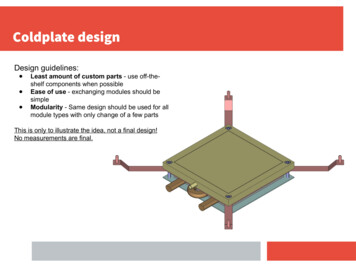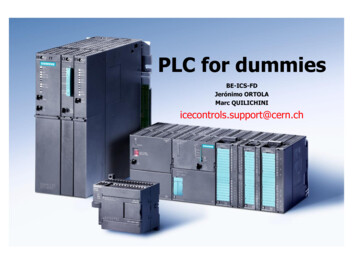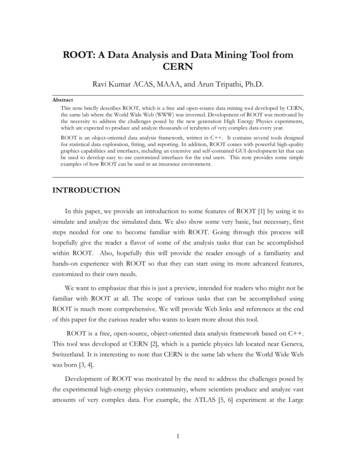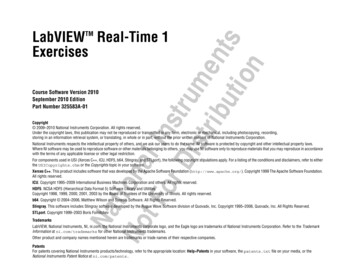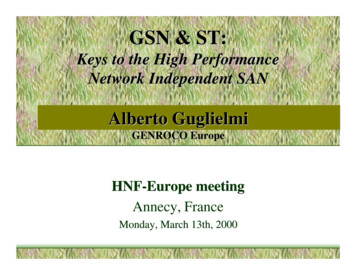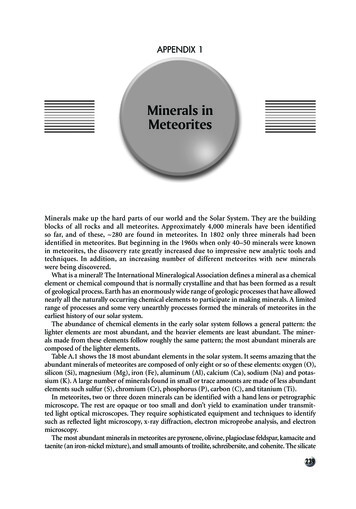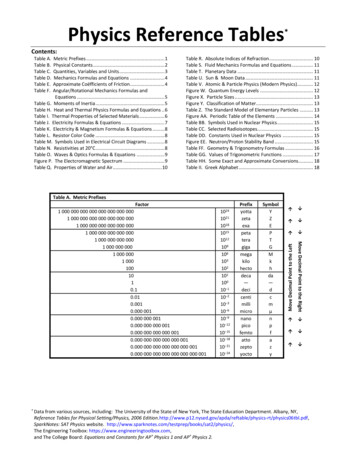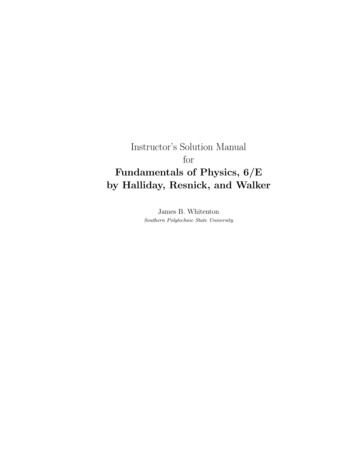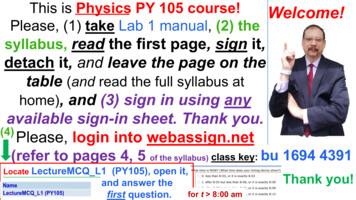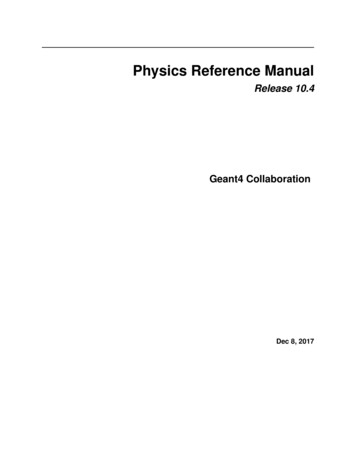
Transcription
Physics Reference ManualRelease 10.4Geant4 CollaborationDec 8, 2017
CONTENTS:1Introduction1.1 Introduction . . . . . . . . . .1.1.1Scope of This Manual .1.1.2Definition of Terms . .1.2 Monte Carlo Methods . . . . .1.3 Particle transport . . . . . . . .1111122Transportation2.1 Transportation . . . . . . . . . . . . . . . . . . . . . . . . . . . . . . . . . . . . . . . . . . . . . .553Decay3.1 Decay . . . . . . . . . . . . . . . . . . . . . . . . . . . . . . . . . . . . . . . . . . . . . . . . . . .3.1.1Mean Free Path for Decay in Flight . . . . . . . . . . . . . . . . . . . . . . . . . . . . . .3.1.2Branching Ratios and Decay Channels . . . . . . . . . . . . . . . . . . . . . . . . . . . . .77774Electromagnetic4.1 Gamma incident . . . . . . . . . . . . . . . . . . . . . . . . . .4.1.1Introduction . . . . . . . . . . . . . . . . . . . . . . . .4.1.2PhotoElectric effect . . . . . . . . . . . . . . . . . . . .4.1.3Compton scattering . . . . . . . . . . . . . . . . . . . .4.1.4Gamma Conversion into 𝑒 𝑒 Pair . . . . . . . . . . . .4.1.5Gamma Conversion into 𝜇 𝜇 Pair . . . . . . . . . . .4.2 Elastic scattering . . . . . . . . . . . . . . . . . . . . . . . . . .4.2.1Multiple Scattering . . . . . . . . . . . . . . . . . . . .4.2.2Discrete Processes for Charged Particles . . . . . . . . .4.2.3Single Scattering . . . . . . . . . . . . . . . . . . . . .4.2.4Ion Scattering . . . . . . . . . . . . . . . . . . . . . . .4.2.5Single Scattering, Screened Coulomb Potential and NIEL4.2.6Electron Screened Single Scattering and NIEL . . . . . .4.2.7 G4eSingleScatteringModel . . . . . . . . . . . . . . . .4.3 Energy Loss of Charged Particles . . . . . . . . . . . . . . . . .4.3.1Mean Energy Loss . . . . . . . . . . . . . . . . . . . .4.3.2Energy Loss Fluctuations . . . . . . . . . . . . . . . . .4.3.3Correcting the Cross Section for Energy Variation . . . .4.3.4Conversion from Cut in Range to Energy Threshold . . .4.3.5Photoabsorption Ionization Model . . . . . . . . . . . .4.4 Electron and Positron Incident . . . . . . . . . . . . . . . . . . .4.4.1Ionization . . . . . . . . . . . . . . . . . . . . . . . . .4.4.2Bremsstrahlung . . . . . . . . . . . . . . . . . . . . . .4.4.3Positron - Electron Annihilation . . . . . . . . . . . . 1i
.4.4Positron Annihilation into 𝜇 𝜇 Pair in Media . . . . . .4.4.5Positron Annihilation into Hadrons in Media . . . . . . .Low Energy Livermore . . . . . . . . . . . . . . . . . . . . . . . .4.5.1Introduction . . . . . . . . . . . . . . . . . . . . . . . . .4.5.2Compton Scattering . . . . . . . . . . . . . . . . . . . . .4.5.3Compton Scattering by Linearly Polarized Gamma Rays .4.5.4Rayleigh Scattering . . . . . . . . . . . . . . . . . . . . .4.5.5Gamma Conversion . . . . . . . . . . . . . . . . . . . . .4.5.6Pair production by Linearly Polarized Gamma Rays . . . .4.5.7Triple Gamma Conversion . . . . . . . . . . . . . . . . .4.5.8Photoelectric effect . . . . . . . . . . . . . . . . . . . . .4.5.9Electron ionisation . . . . . . . . . . . . . . . . . . . . .4.5.10 Bremsstrahlung . . . . . . . . . . . . . . . . . . . . . . .Low Energy Penelope . . . . . . . . . . . . . . . . . . . . . . . .4.6.1Penelope physics . . . . . . . . . . . . . . . . . . . . . .Monash University low energy photon processes . . . . . . . . . .4.7.1Monash Low Energy Photon Processes . . . . . . . . . . .Charged Hadron Incident . . . . . . . . . . . . . . . . . . . . . . .4.8.1Hadron and Ion Ionization . . . . . . . . . . . . . . . . .4.8.2Low energy extentions . . . . . . . . . . . . . . . . . . .Muon incident . . . . . . . . . . . . . . . . . . . . . . . . . . . .4.9.1Muon Ionization . . . . . . . . . . . . . . . . . . . . . .4.9.2Bremsstrahlung . . . . . . . . . . . . . . . . . . . . . . .4.9.3Positron - Electron Pair Production by Muons . . . . . . .4.9.4Muon Photonuclear Interaction . . . . . . . . . . . . . . .Atomic Relaxation . . . . . . . . . . . . . . . . . . . . . . . . . .4.10.1 Atomic relaxation . . . . . . . . . . . . . . . . . . . . . .Geant4-DNA . . . . . . . . . . . . . . . . . . . . . . . . . . . . .4.11.1 Geant4-DNA processes and models . . . . . . . . . . . .Microelectronics . . . . . . . . . . . . . . . . . . . . . . . . . . .4.12.1 The MicroElec extension for microelectronics applicationsPolarized Electron/Positron/Gamma Incident . . . . . . . . . . . .4.13.1 Introduction . . . . . . . . . . . . . . . . . . . . . . . . .4.13.2 Ionization . . . . . . . . . . . . . . . . . . . . . . . . . .4.13.3 Positron - Electron Annihilation . . . . . . . . . . . . . .4.13.4 Polarized Compton scattering . . . . . . . . . . . . . . . .4.13.5 Polarized Bremsstrahlung for electron and positron . . . .4.13.6 Polarized Gamma conversion into an electron–positron pair4.13.7 Polarized Photoelectric Effect . . . . . . . . . . . . . . .X-Ray production . . . . . . . . . . . . . . . . . . . . . . . . . .4.14.1 Transition radiation . . . . . . . . . . . . . . . . . . . . .4.14.2 Scintillation . . . . . . . . . . . . . . . . . . . . . . . . .4.14.3 Čerenkov Effect . . . . . . . . . . . . . . . . . . . . . . .4.14.4 Synchrotron Radiation . . . . . . . . . . . . . . . . . . .Optical Photons . . . . . . . . . . . . . . . . . . . . . . . . . . .4.15.1 Interactions of optical photons . . . . . . . . . . . . . . .Phonon-Lattice interactions . . . . . . . . . . . . . . . . . . . . .4.16.1 Introduction . . . . . . . . . . . . . . . . . . . . . . . . .4.16.2 Phonon Propagation . . . . . . . . . . . . . . . . . . . . .4.16.3 Lattice Parameters . . . . . . . . . . . . . . . . . . . . .4.16.4 Scattering and Mode Mixing . . . . . . . . . . . . . . . .4.16.5 Anharmonic Downconversion . . . . . . . . . . . . . . .Precision multi-scale modeling . . . . . . . . . . . . . . . . . . .4.17.1 Overview . . . . . . . . . . . . . . . . . . . . . . . . . 3
4.17.2 Impact ionisation by hadrons and PIXE . . . . . . . . . . . . . . . . . . . . . . . . . . . . 1844.18 Shower Parameterizations . . . . . . . . . . . . . . . . . . . . . . . . . . . . . . . . . . . . . . . . 1874.18.1 Gflash Shower Parameterizations . . . . . . . . . . . . . . . . . . . . . . . . . . . . . . . . 18756Hadronic5.1 Elastic . . . . . . . . . . . . . . . . . . . . . . . . . . . . . . . . . .5.1.1Coherent elastic scattering . . . . . . . . . . . . . . . . . . .5.2 Elastic he . . . . . . . . . . . . . . . . . . . . . . . . . . . . . . . .5.2.1Hadron-nucleus Elastic Scattering at Medium and High Energy5.3 LowEnergyChargedParticles . . . . . . . . . . . . . . . . . . . . . . .5.3.1Low Energy Charged Particle Interactions . . . . . . . . . . .5.4 LowEnergyNeutrons . . . . . . . . . . . . . . . . . . . . . . . . . . .5.4.1Geant4 Low Energy Nuclear Data (LEND) Package . . . . . .5.4.2Neutrons . . . . . . . . . . . . . . . . . . . . . . . . . . . .5.5 LPBias . . . . . . . . . . . . . . . . . . . . . . . . . . . . . . . . . .5.5.1Leading Particle Bias . . . . . . . . . . . . . . . . . . . . . .5.6 Radioactive Decay . . . . . . . . . . . . . . . . . . . . . . . . . . . .5.6.1Radioactive Decay . . . . . . . . . . . . . . . . . . . . . . .5.7 Stopping . . . . . . . . . . . . . . . . . . . . . . . . . . . . . . . . .5.7.1Complementary parameterised and theoretical treatment . . .5.7.2Pion absorption at rest . . . . . . . . . . . . . . . . . . . . .5.7.3Interactions of Stopping Particles . . . . . . . . . . . . . . . .5.8 Theory-Driven . . . . . . . . . . . . . . . . . . . . . . . . . . . . . .5.8.1Abla . . . . . . . . . . . . . . . . . . . . . . . . . . . . . . .5.8.2AbrasionAblation . . . . . . . . . . . . . . . . . . . . . . . .5.8.3The Geant4 Binary Cascade . . . . . . . . . . . . . . . . . .5.8.4CrossSection . . . . . . . . . . . . . . . . . . . . . . . . . .5.8.5Evaporation . . . . . . . . . . . . . . . . . . . . . . . . . . .5.8.6Fermi Breakup . . . . . . . . . . . . . . . . . . . . . . . . .5.8.7Fission model . . . . . . . . . . . . . . . . . . . . . . . . . .5.8.8Fritiof (FTF) Model . . . . . . . . . . . . . . . . . . . . . . .5.8.9Gamma Interaction . . . . . . . . . . . . . . . . . . . . . . .5.8.10 Incl . . . . . . . . . . . . . . . . . . . . . . . . . . . . . . .5.8.11 Multifragmentation . . . . . . . . . . . . . . . . . . . . . . .5.8.12 Parton string . . . . . . . . . . . . . . . . . . . . . . . . . . .5.8.13 Parton string . . . . . . . . . . . . . . . . . . . . . . . . . . .5.8.14 QMD . . . . . . . . . . . . . . . . . . . . . . . . . . . . . .5.8.15 Stopped Absorption . . . . . . . . . . . . . . . . . . . . . . 329Photolepton6.1 Introduction . . . . . . . . . . . . . . . . . . . . . . . . . . . . . . . . . . . . .6.2 Cross-sections in Photonuclear and Electronuclear Reactions . . . . . . . . . . . .6.2.1Approximation of Photonuclear Cross Sections. . . . . . . . . . . . . . .6.2.2Electronuclear Cross Sections and Reactions . . . . . . . . . . . . . . . .6.2.3Common Notation for Different Approaches to Electronuclear Reactions .6.3 Gamma-nuclear Interactions . . . . . . . . . . . . . . . . . . . . . . . . . . . . .6.3.1Process and Cross Section . . . . . . . . . . . . . . . . . . . . . . . . .6.3.2Final State Generation . . . . . . . . . . . . . . . . . . . . . . . . . . .6.4 Electro-nuclear Interactions . . . . . . . . . . . . . . . . . . . . . . . . . . . . .6.4.1Process and Cross Section . . . . . . . . . . . . . . . . . . . . . . . . .6.4.2Final State Generation . . . . . . . . . . . . . . . . . . . . . . . . . . .6.5 Muon-nuclear Interactions . . . . . . . . . . . . . . . . . . . . . . . . . . . . . .6.5.1Process and Cross Section . . . . . . . . . . . . . . . . . . . . . . . . .6.5.2Final State Generation . . . . . . . . . . . . . . . . . . . . . . . . . . .337337337337339339344344344344344344345345345.iii
iv
CHAPTERONEINTRODUCTION1.1 Introduction1.1.1 Scope of This ManualThe Physics Reference Manual provides detailed explanations of the physics implemented in the Geant4 toolkit.The manual’s purpose is threefold: to present the theoretical formulation, model, or parameterization of the physics interactions included in Geant4, to describe the probability of the occurrence of an interaction and the sampling mechanisms required to simulateit, and to serve as a reference for toolkit users and developers who wish to consult the underlying physics of an interaction.This manual does not discuss code implementation or how to use the implemented physics interactions in a simulation.These topics are discussed in the User’s Guide for Application Developers. Details of the object-oriented design andfunctionality of the Geant4 toolkit are given in the User’s Guide for Toolkit Developers. The Installation Guide forSetting up Geant4 in Your Computing Environment describes how to get the Geant4 code, install it, and run it.1.1.2 Definition of TermsSeveral terms used throughout the Physics Reference Manual have specific meaning within Geant4, but are not welldefined in general usage. The definitions of these terms are given here. process - a C class which describes how and when a specific kind of physical interaction takes place alonga particle track. A given particle type typically has several processes assigned to it. Occaisionally “process”refers to the interaction which the process class describes. model - a C class whose methods implement the details of an interaction, such as its kinematics. One or mor
The Physics Reference Manual provides detailed explanations of the physics implemented in the Geant4 toolkit. The manual’s purpose is threefold: to present the theoretical formulation, model, or parameterization of the physics interactions included in Geant4, to describe the probability of the occurrence of an interaction and the sampling mechanisms required to simulate it, and to .

